Omnibus/OHC Graphic Novel Collectors discussion
OHC Miscellamania
>
A.E. & OHC's of Any Kind: Reviews, Comments, & Voodoo Curses
date newest »
newest »
 newest »
newest »
 5 More Great AE's/OAFs: Ramble 2
5 More Great AE's/OAFs: Ramble 2
006.

 Will Eisner's The Spirit: Artist's Edition - Volumes 1 & 2
Will Eisner's The Spirit: Artist's Edition - Volumes 1 & 2These are fucking essential. Every 'Spirit' collection I'd read before these two books failed miserably to convey the genius of Eisner's prime artistry. No missing pages, beautifully designed... 300 pages of Eisner's best stories.

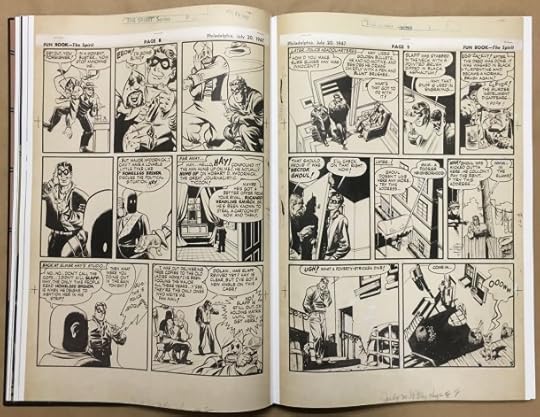
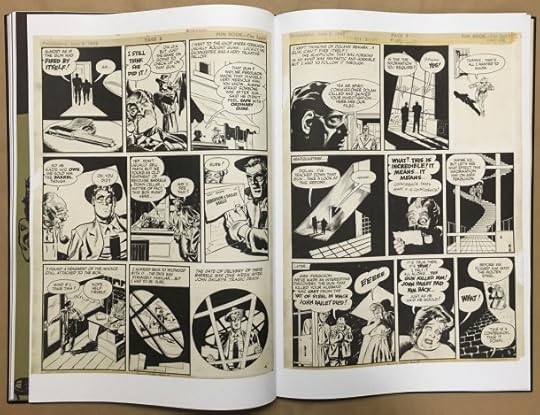
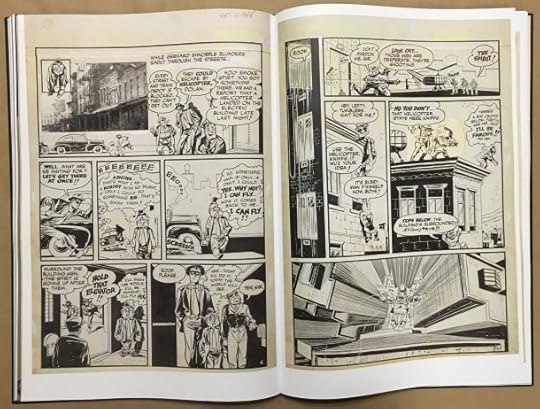
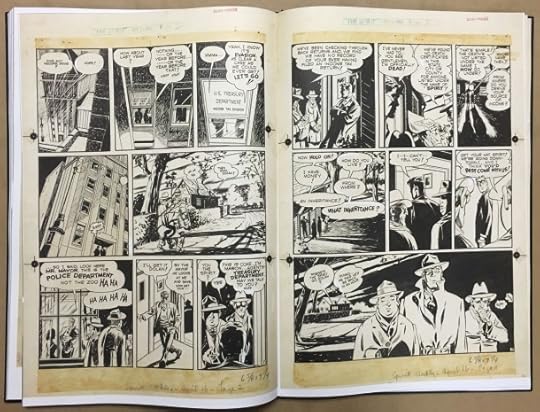
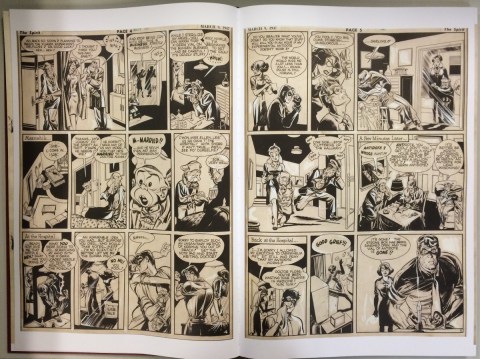


007.
 Mike Mignola's The Amazing Screw-On Head & Other Curious Objects Artist's Edition
Mike Mignola's The Amazing Screw-On Head & Other Curious Objects Artist's EditionThe first Mike Mignola Artist's Edition, 'Hellboy in Hell', was fucking spectacular, but some reviewers complained about the lack of story... literally. The balloons and lettering were added digitally, so the original art was ALL art. That was fine with me... I had the trade. But the second A.E., 'Amazing Screw-On Head' is the best of the 12 x 17-inch books, no question. That, however, is entirely related to my admiration for the work of Mignola; while Hellboy in Hell gave us late-period Mignola and a couple very cool bonuses like the early-90's Hellboy classic 'The Corpse', the newer book gives us eclectic and first-rate stories from throughout his career, & a killer cover gallery.
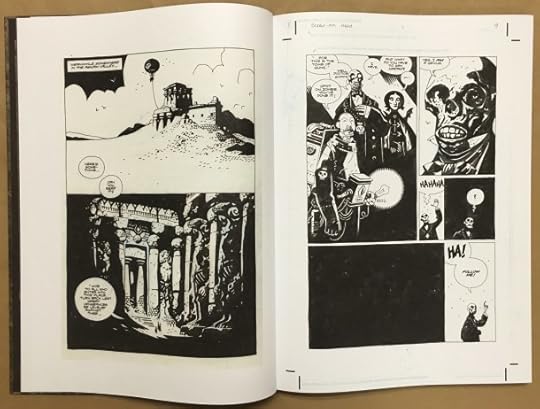
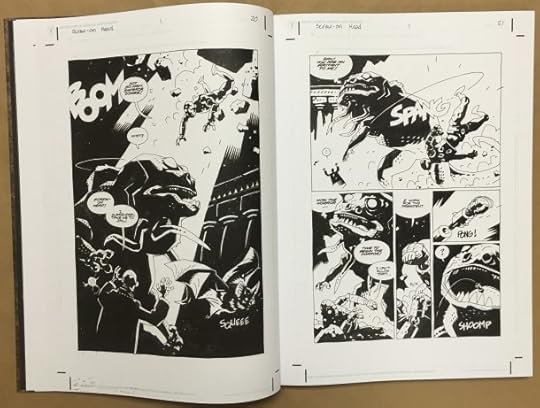
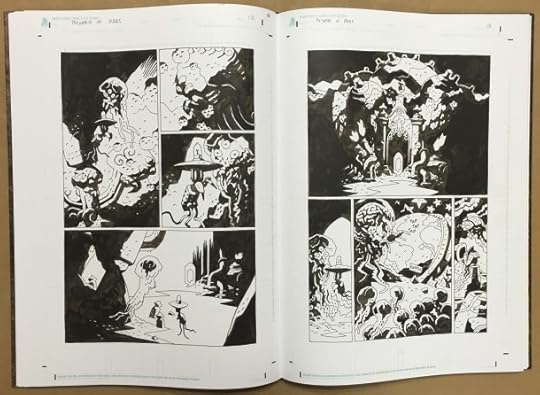



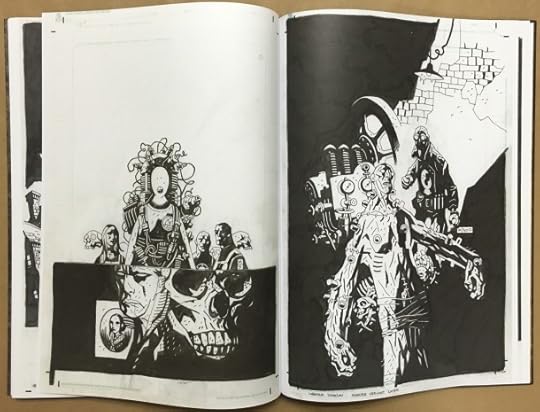
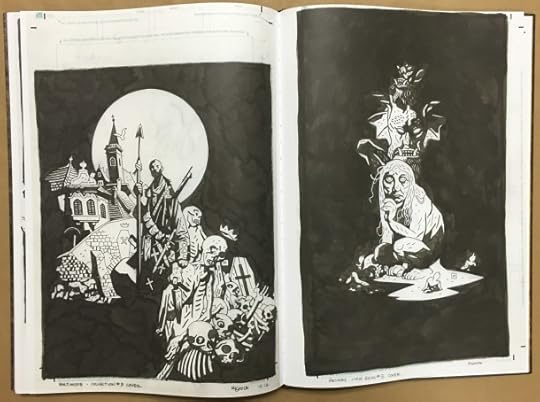
008.
 Steranko: Nick Fury - Agent of SHIELD Artist Edition
Steranko: Nick Fury - Agent of SHIELD Artist EditionJim Steranko, motherfucker. He out-Kirby-ed the king, made that shit look easy, dropped the mic, and bitch-slapped Bob Kane for being an over-rated, pretentious snob. Also: this is one of the most popular artist editions for good reason.
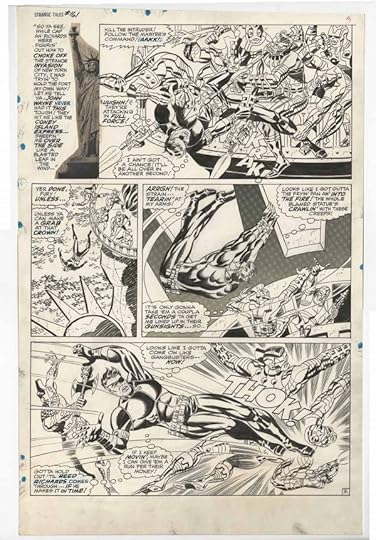
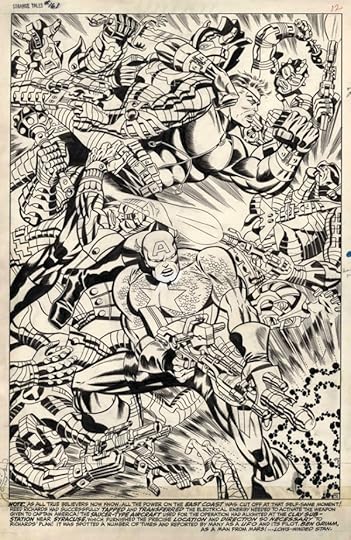
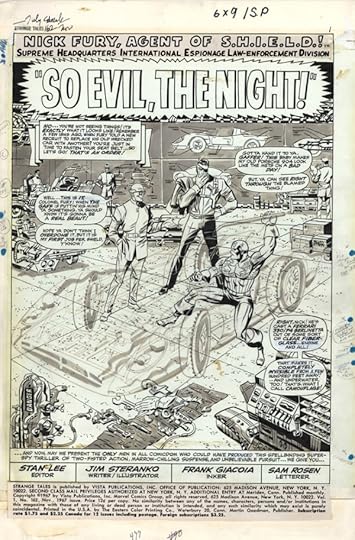
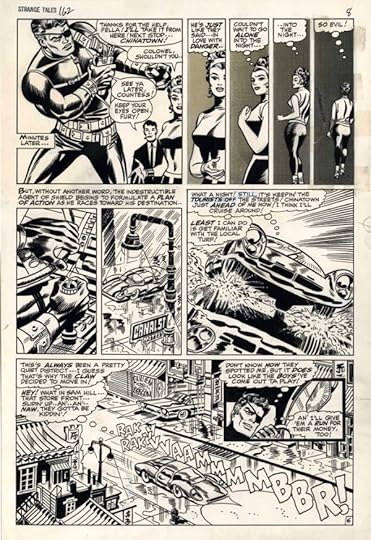
009.
 The Best of DC War - Artist’s Edition
The Best of DC War - Artist’s Edition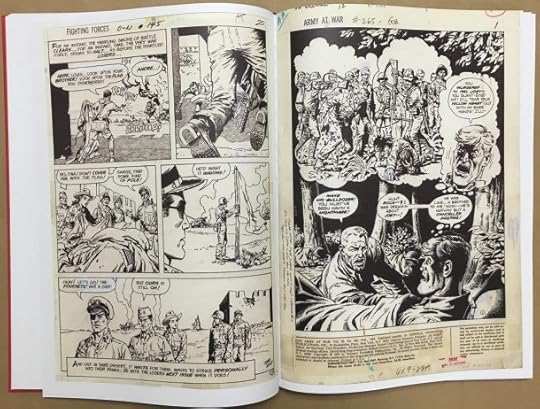
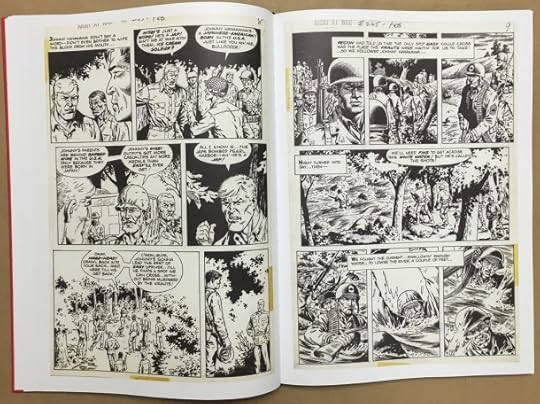
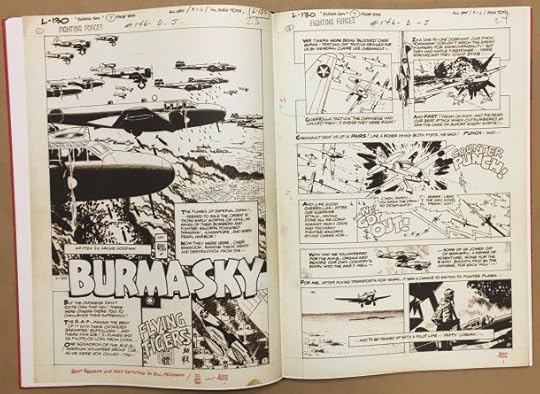
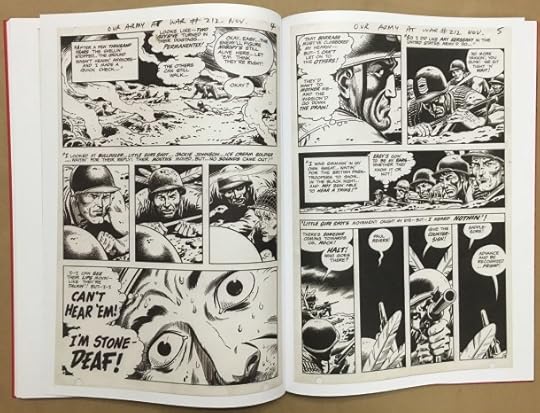
010.
 Basil Wolverton's Weird Worlds - Artists Edition
Basil Wolverton's Weird Worlds - Artists EditionIf Harvey Kurtzman was the Godfather of underground comics, Basil Wolverton was it's creepy uncle. No one drew like Wolverton, with his 'spaghetti and meatballs' style that blew the minds of Crumb and Wilson and so many others. Even after he became devoutly religious, he still became a mentor and friend of sorts to the artist who published the most transgressive, brutal, sexually violent, and perfectly UN-Christian comics of the time, S. Clay Wilson.
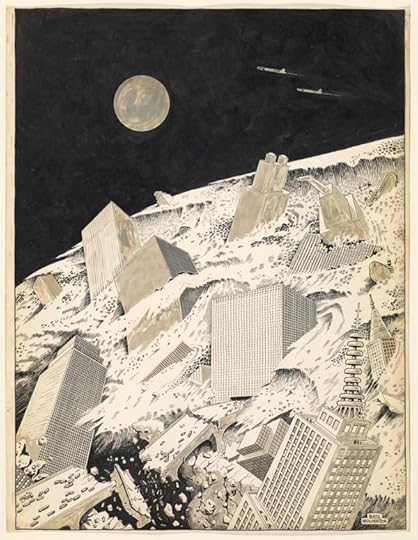
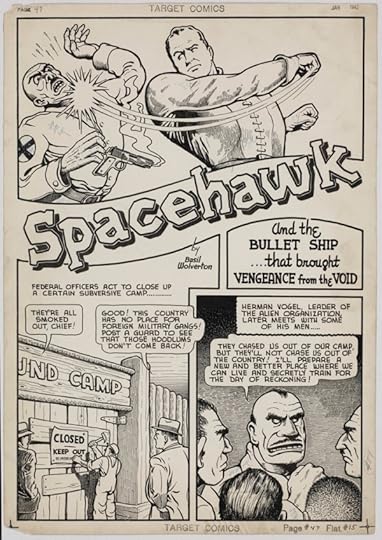
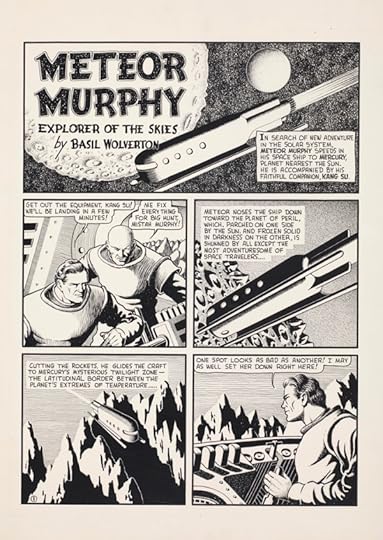
IDW, thanks to series editor Scott Dunbier, have made some very smart choices in artists and subject matter; I'm not interested in a lot of their titles, but there aren't many that I find baffling. Graphitti Designs, on the other hand... dafuq? Amanda Conner is talented, but there's literally hundreds of artists that deserve a book more, in terms of longevity, talent, originality and influence. But Conner is still a legit talent, while publishing Gallery Editions devoted to Michael Turner's 90's hack-work, or the TWO books dedicated to Kelley Jones' cut-rate Bernie Wrightson replication, just seems fucking odd.
 Absolute: Top 10 & Alan Moore ramble...
Absolute: Top 10 & Alan Moore ramble...
It's interesting that Alan Moore, who absolutely hated DC and Marvel and professed utter boredom with superheroes in general, decided to create another superhero comic when he launched ABC almost 15 years ago. While he comes across as a crotchety old bastard, his feelings toward DC were entirely justified. Way back in the early 80's, after blowing the minds of comic geeks with his brilliant and definitive take on 'Swamp Thing', DC was excited to put their young British genius to work on a superhero title. Moores' proposal for an epic restructuring of the DC universe scared the hell out of them, however, so they compromised. Instead of traumatizing Green Lantern and Wonder Woman fans, he could inflict whatever indignities he liked upon a long-forgotten world of characters created for Charlton comics in the 40's, 50's & 60's.
From 'Watchmen' [Dave Gibbons] and 'A Small Killing' [Oscar Zarate]:


DC had purchased Charlton to acquire specific properties, but the titles Moore was given Carte Blanche with were afterthoughts. The characters in Watchmen bear little resemblance to the original Charlton heroes, and the story that unfolded over 12 issues was the pure, concentrated genius that resides in the mighty beard of Alan Moore. Watchmen became the consensus No.1 superhero comic of all time; some list Miller's 'The Dark Knight Returns' as a close competitor for the top spot, and Miller is great, but... c'mon. Really? Anyway, the unprecedented success of Watchmen, both initially and to this very day, with multiple editions in print for almost 30 years, with a massive multi-volume 'Before Watchmen' series of prequels, and with a feature film adaptation with a huge budget and '300' director Zach Snyder at the helm, Moore received little more than a pittance... his initial payment for writing 'Watchmen' would be his last, and he was given no further creative input.
From 'Lost Girls' & 'From Hell':


He left DC, outraged by their utter disrespect for his abilities as a writer, treating every employee as faceless, replaceable, certainly not like artists. He devoted himself to various projects for independent publishers, most of which are lesser known masterpieces -- A Small Killing, Lost Girls, Big Numbers (his legendary failed collaboration with Bill Sienkiewicz), and of course, From Hell. After showing his support for the artists who had quit Marvel and DC to form Image by guest-writing a few of their terrible, godawful comics, he took one of the worst of them, Supreme, a blatant Superman ripoff, and launched a thoroughly brilliant run; thus, Moore became a true comic-book alchemist, able to turn crap into gold(*). It was after Supreme wrapped up it's storyline that Moore began talks with former X-men artist fan-favorite and Image co-founder Jim Lee, about masterminding an entire line of books, to be called America's Best Comics.
From 'League of Extraordinary Gentleman' [Kevin O'Neill]:


Immediately after finalizing his deal to create ABC for Jim Lee's Wildstorm -- at that point published by Image -- DC swooped in and made Lee an offer he couldn't refuse. They purchased the artist-superstars' line of mostly mediocre titles, for the sole purpose of acquiring lucrative rights and forcing Moore into a partnership with the company who had already screwed him out of millions of dollars(**). Despite Lee's promise to act as a buffer between Moore and the army of lawyers, editors and vice-presidents at DC, they still found ways to drive him insane; most notably (and despicably) by trying to ensure his docile compliance by hiring the writers' old friend Steve Moore (no relation), in dire need of a paying job, and suggesting that his future at DC was in Alan's hands. They then pushed him further by nitpicking over inconsequential details in the League of Extraordinary Gentlemen (The Black Dossier most of all), and turning what is Moore's third greatest masterpiece -- after Watchmen and From Hell -- into one of the worst film adaptations of all time. The proverbial insult that followed the injury was the ludicrous, infuriating and hurtful accusation that Moore (conspiring with DC) stole the idea for LOEG from an abysmal screen-writer(***). While DC owned the movie rights, Moore retained ownership and creative control of LOEG. Once again disgusted with the company, he decided to shut down ABC and take LOEG to independent Top Shelf, where he has enjoyed total autonomy, publishing the collected LOEG: Vol. III - Century, as well as three hardcover 'Nemo' books.
From Absolute Top 10 - Top 10, Art by Alex Ross and Gene Ha:



What was saddest about the whole debacle is that the ABC titles were uniformly excellent. Perhaps the best of the four titles was Top Ten. Moore's police procedural, set in a city inhabited by millions of costumed superheroes, supervillains, aliens, robots and gods, is a densely layered drama packed with unforgettable characters. So many scenes stand out it's hard to narrow them down:
One story, involving a teleport station used not just by beings from our world (or our galaxy), but also Extra-Dimensional Entities navigating endless Multiversal levels, is especially poignant: A horrible teleportation accident involving an elderly superhero couple and a Horse-headed Alien Giant, late for his cosmic chess-game, leaves both parties fused together, slowly dying, involving the reader in the emotional agony of both the victims and the investigators, searching for answers as they wait, helpless, for the doomed individuals to expire (See the third pic below).
An alien serial killer is killing prostitutes, and super-powered cops apparently aren't enough to stop the murders; not only is the killer freakishly good at ending lives, SHE has friends in high places.
A supposedly friendly cross-precinct cop exchange with an alternate-universe-Top Ten -- this one a Global Roman Empire, ruled directly by capricious and familiar gods -- turns out to actually be a brutal gladiatorial contest. Involving Top Ten members from Precincts across the Multiverse, Detective Corbeau, aka King Peacock, will have to call upon all his Satanic powers in order to survive. A 70-ft tall woman made of marble is one thing, but fighting his brand-new pal is another... even if he is a robotic Velociraptor of gleaming steel (See below).
From Absolute Top 10 - Top 10, Art by Gene Ha:



The entire series is collected in one massive Absolute edition, along with the two mini-series that were written by Moore. Despite all the ill will that has tainted his relationship with the Big Two companies, and though Moore denies it, there remains an affinity for the superhero genre, evident throughout every beautiful page of this book. Never mind the hundreds of terribly written, terribly drawn juvenile power fantasies churned out on a monthly basis. Moore once again points the way for comics done right, packing this 632-page (not the 576 pages it's listed as, making it one of the biggest of the Absolute Editions), 9" x 13" volume with all the cool ideas it can safely contain without spontaneously combusting. The artwork of Gene Ha and Zander Cannon, however, is the real reason that an Absolute Edition is so welcome and long overdue. These two artists are responsible for every panel of art in this volume, with Cannon doing layouts and Ha focusing on his meticulous dry-brush finishes. For the 'Through-the Looking-Glass' trip into the unexpectedly cuddly world that is the setting for the 5-issue series based on Top Ten bad-ass 'Smax', Cannon took the reins, managing the tightrope between realism and cartoonish effectively, a skilfully stylized art that can handle both humor and tragedy. It reminds me of Sfar and Trondheim's epic 'Donjon', in many ways.
From Absolute Top 10 - Smax, art by Zander Cannon:



For the Top Ten prequel 'The 49ers', Gene Ha returns, utilizing the Ink-wash method used by artists like Lee Bermejo & J.H.Williams III, creating finely wrought gradations of light, shadow and texture in grey-tones. After computer-coloring is applied, the finished results are near indestinguishable from watercolors, making 'The 49ers' one of the most beautiful American comics of its' time, similar to Euro-comics in both its strong linework & fully painted colors. The retro-futuristic architecture of Neopolis is rendered in a level of detail that is remarkable, making excellent use of the oversized format. While I'm not the biggest fan of superhero comics, and I think that many of the books given the Absolute treatment don't merit the luxury edition, Top Ten is one of the best mainstream comics of the last two decades, and this book is definitely worth the asking price. Considering the narrative and artistic density packed into this truly complete, Omnibus-sized Absolute Edition, If you've considered picking up an Absolute, I recommend 'Absolute Top 10' absolutely.
From Absolute Top 10 - The 49ers, art by Gene Ha:



 We Stand on Guard
We Stand on Guard

NOTE: Foul language. Some spoilers, but the summary doesn't give away much skipping the dramatic twists and turns. Proceed with CAUTION.
Yay! More Canlit (sort of) that doesn't double as a sleep-aid! After decades of government grants and dull essays and hand-wringing over the Canadian identity, a comic-book by the Cleveland-born-Canadian-by-marriage B.K. Vaughan and Genuine-Canadian Steve Skroce has finally given us a reason to be proud of our national heritage. Although... it's speculative fiction that takes place 100 years in the future, and may have been dreamt up after Vaughan got stoned and watched 'The Empire Strikes Back' immediately after the 'South Park' movie, in a serendipitous twist of programming. Fuck it. Good enough. At this point, we Canadians will take what we can get. Umm... up to but probably NOT including manifest destiny and the draining of Great Slave Lake.

To be brutally honest, we don't seem to be all that good at revolution and overthrowing oppressive despots and whatnot. And our government doesn't seem that good at saying 'no' to the US. We usually eschew guerilla warfare and rail-guns for petitions and novels by Margaret Laurence and Hugh Maclennan that nobody really likes... not even us. For any Canadians getting confused and irate, muttering something like "what the fuck is this guy babbling

You tell 'em!
As terrible as BKV seems to be for television - 'Under the Dome' is a crime for which he will never be forgiven - he keeps doing things right in comics: 'Paper Girls', 'Runaways', 'Y: The Last Man', 'Ex Machina', 'Pride of Baghdad', 'Saga', 'The Private Eye', 'The Walking Dead: The Alien', etc. He has his faults and weaknesses as a writer - lame, jokey dialogue being one of them, but those goofier tendencies are fading - but he's very talented. And Vaughan's 'big-idea-generator' is obviously still functioning smoothly; even if 'Saga' and 'We Stand on Guard' aren't as easy to pitch as 'Y: The Last Man', they're his best titles so far. And 'We Stand on Guard' is already my favorite of the two. Crazy, I know. It's a fun little tale about the White House being bombed and the US deciding to obliterate Canada and occupy the smoldering wreckage. 'Saga' is... well, 'Saga'. The big fucking space opera epic that even non-comic readers love. Nevertheless. Being Canadian adds a cool and righteous twist to the proceedings that Canadians rarely get from their fiction... but I always root for the 'freedom fighters', underdogs, and bad guys anyway.


But the artwork is what makes this truly spectacular. All that time hanging around Geof Darrow did some very good things to Skroce's style. His art was always well-executed -- especially when compared to the work of other Marvel and Image artists from the 90's -- but the Euro-comic clean-line style he lets loose with here is fucking incredible, made even better by the painted colors of Matt Hollingsworth. Digitally painted, I guess, though he's been known to use a real brush, too... it's a testament to his skills that it's hard to tell at times. He's still one of the very best colorists in comics, showing his usual subtlety, restraint, and tastefully muted palette. But Skroce’s the star of this show, drawing the hell out of every panel, showing his gift for realistic mechanical designs on the many 22nd century vehicles and weapons and Otomo-Shirow-brand Mecha-monstrosities. The bold black outlines, minute detail and economical texturing all suggest the strong Geof Darrow influence, though Skroce has his own stylistic idiosyncrasies. And if you don't think the years spent working as a farmhand with Darrow on the Wachowski Concept and Storyboard Art-Ranch is behind his awesome artistic metamorphosis, here's exhibit 'A' -- from the mid-00's, his last trip to the world of comics before WSOG:
Skroce's comic 'Doc Frankenstein', published by Burlyman -- the Wachowski-owned comic-book publisher devoted exclusively to Skroce and Geof Darrow. Doc Frankenstein is definitely in long-time Darrow territory here, in a Shaolin Cowboy-inspired spread:

As wacky and implausible as the premise might sound at first, it's tone is a bit darker than I expected, though far from gloomy. The violence gets very brutal, and it's made all the more shocking by the ultra-fine details of Skroce's rendering. Suspending the knee-jerk disbelief isn't all that difficult either, when you consider the historical precedents, and ruminate on how dramatically the fate of friends and nations can change over the course of a century.
The story begins in Ottawa, with a family watching news footage of the drone bombing that will soon change everything. After her parents are killed in America's not-so-witty rejoinder to the White House attack, bombing Ottawa flatter than the prairies, we follow young Amber across 12 years and thousands of kilometers, North(ish) into the Yukon Territories. She is now alone and hunting caribou -- her older brother Tommy was apparently captured by the Americans -- when she encounters a patrolling 'Dog of War' sentry and is rescued by an appropriately rag-tag group of spunky resistance fighters calling themselves 'The Two-Four'. A Lucasfilm homage follows when the Two-Four take on a massive AT-AT-type mecha-beast on their snowy sub-Artic battlefield, culminating in some dramatically bloody surprises as they welcome Amber to the fold.
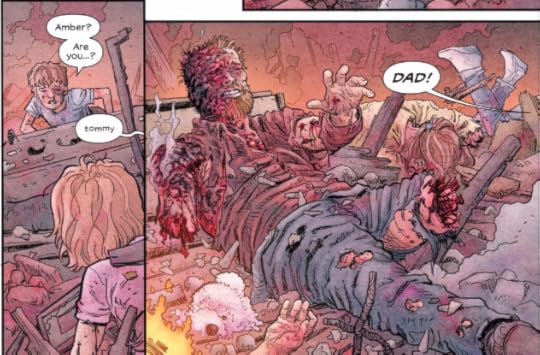


She passed her first test, but Amber still gets blindfolded as she's led to the good ol' secret rebel base. When one of the Two-Four is captured, we get to see what the 'humane torture' of the future might look like, since there's always going to be people who can claim something like 'humane torture' exists and actually believe it. Things get stickier for our rebel heroes, as the possibility of discovery threatens their base, knowing that even the strongest person will eventually break under torture; but their reclamation projects involving fallen mecha-monsters makes them unwilling to leave until they know they've been given up. By then, of course, it'll probably be too late. The plot moves quickly, but I found myself deliberately slowing to examine the art -- that's usually the sign of a 5-star comic, and this is no exception. For a 160-page story, the characters are remarkably well-defined, with the quick and broad brush-strokes that writing like this requires. Amber and her brother's story is told in brief flashbacks throughout the 6-issue run; even though something ominous seemed to be building up steam, but never really materialized as the huge, shocking twist I was waiting for, I can't complain about a writer failing to be predictable. The huge Great Slave Lake showdown between the army of drones and robo-puppies, led by the patriotic torturess known (somewhat ironically) as 'The American', and the far-overmatched Two-Four rebels, is a thing of terrible and entertaining beauty. BKV doesn't give the reader anything mind-blowing with 'We Stand on Guard', but it has originality, excitement and clever details a-plenty.



Another way that this book excels is as a low-key satire; 'We Stand on Guard' takes US foreign policy to its final, logical absurdity, substituting oil for water and long-demonized nations like Iraq for America's closest friend and ally. The ecological warnings are there too, of course. But if that sort of thing just annoys you, don't worry about it. This isn't obnoxiously preachy or self-righteous, and the satire's light enough that you could say I imagined it. You'd be wrong, but you could say it.
Finding authentically and exclusively Canadian touchstones -- not the lame shit about beer and hockey, I'm thinking more along the lines of Farley Mowat or Degrassi Junior High -- isn't that easy for outsiders like BKV... so I particularly appreciated the details, like the brief reference to 'The Littlest Hobo'. The theme song to 'The Littlest Hobo' should replace 'O, Canada' as the national anthem.
The Canadian 'Dog of War'! If you don't believe a dog can use a rifle, you're seriously underestimating 'The Littlest Hobo'. He beat former-PM Jean Chretien at 'Scrabble', convinced Quebec to give national unity another shot, AND foiled the kidnappers by saving the wealthy rancher's daughter!

Since I've been stuck reading digital copies, I'm looking forward to this deluxe hardcover version, though it's going to be a five month wait. Image always does a great job with their collected editions. Liberté, égalité, fraternité! (No, it's not Canadian, but all our motto's suck.)
 Sandman - Overture: J.H. Williams III Steals the Show
Sandman - Overture: J.H. Williams III Steals the Show


Despite all the unfair shit-talking that's been done about 'Sandman' over the years, criticism about the mediocre-tending-toward-awful artwork that plagues the early-going of the series are legitimate. As unfortunate as it is that between 'Vol. 1 - Preludes and Nocturnes' and 'Vol.4 - Season of Mists', the art is tolerated more than enjoyed, Gaiman's still evolving ideas were strong enough to keep readers interested. The early material has been re-colored, and one issue completely re-inked. The first couple volumes aren't some tedious chore to suffer through; the story just improves dramatically with every chapter. Gaiman settled in by volume 4, and artists Jill Thompson, P. Craig Russell, Jon J. Muth, Charles Vess, Marc Hempel, Teddy Kristiansen, Bryan Talbot, and Michael Zulli made the last 6 of the 10 collected editions into some of the best artistic performances DC produced in the 1990's. Moving from Sam Keith's crude, Wrightson-inspired style to Mike Zulli's meticulous work on 'The Wake' -- the first mainstream comic to use uninked, intricately rendered colored pencils -- is an evolutionary progression that mirrors the journey that Morpheus makes through the series, and in a way, the art balances out.
The Bad Ol' Days -- Sam Keith's terrible art*{See Footnote Below} from the first collected edition:


Impressive work by Michael Zulli and Teddy Kristiansen, respectively, from 'The Sandman's stellar second half. Kristiansen was filling in for the regular artist of the penultimate, climactic 13-issue story-arc, Marc Hempel, but he nailed this powerful meeting between Morpheus and 'The Kindly Ones':


After the monthly series concluded with issue 75, Vertigo was in deep denial that Morpheus was dead and gone... sort of dead and gone. So, they released 'The Dreaming', a monthly Sandman spinoff, and several 'Sandman Presents', none of them written by Gaiman. He DID write the two 'Death' mini-series, but they appeared while 'The Sandman' was still going. Then Vertigo launched two more Sandman-based monthly series: 'Lucifer', based on the events that took place in 'Season of Mists', when Lucifer quit Hell and moved 'topside' to open a fancy nightclub, recently adapted as a shitty TV show; and 'House of Mystery', based on Gaiman's version of the classic series, relocated to The Dreaming.
Artwork from 'Endless Nights', in order of brilliance: Frank Quitely, Milo Manara, and Miquelanxa Prado (original art, sans word balloons):



When Gaiman returned to his most popular character, it was as a conquering fucking hero, having made his name as a best-selling, critically acclaimed novelist. His first project was an illustrated novella, with beautiful fully-painted art by Yoshitaka Amano; it was later adapted as an equally beautiful comic, by returning monthly-Sandman vet P. Craig Russell. With 'Endless Nights', some of the greatest comic artists from around the world were invited to collaborate on yet another volume of 'The Sandman'; that officially made it the title with some of the worst AND absolute best art in mainstream comics. With each artist handling a Gaiman-scripted chapter devoted to one member of The Endless, it's clear everyone took their assignment very seriously, turning in some of their best work to date (see the above illustrations). Frank Quitely's fully-painted tale of Destiny is perhaps the most stunning 8-pages of comic art you'll ever see, and Milo Manara and Miguelanxo Prada remind the world why they're revered as artistic geniuses of the 9th Art.
From 'Promethea' to 'Batwoman: Elegy' to 'Sandman: Overture'; J.H. William III has become the most inventive and original artist in mainstream comics:



Which finally brings me to 'Overture', Gaiman's epic return to the character of Morpheus, the original 'Dream of the Endless'. Taking place just before the events depicted way back in 'The Sandman' issue 1, when a dying Aleister Crowley-type mage attempts to summon and trap Death, instead pulling in Death's weakened sibling, Dream, we now learn what kind of ordeal he went through before his several decades-long incarceration. It addresses issues like the Corinthian's reign of terror and some of the more confusing paradoxes of Dream's multi-faceted existence... something like a quantum super-position including every conceivable iteration of his 'Endless' avatars: cats and plants and superheroes and aliens and mermen and robots and sentient gas-clouds. The business Morpheus was attending to involved an emergency convocation of his infinite selves, triggered after one of his Endless facets, an intelligent plant-thing, is mysteriously destroyed... but fuck the story. It's great. If you like Gaiman's typical talk of ancient gods and rules and the eloquent narrative shrug he uses to slink past questions like 'why?' and 'what the fuck?', you do yourself no favors by avoiding 'The Sandman'. It's still his deepest and most affecting work. And yet... J.H. Williams III is unquestionably the star of this show.
More exceptional work from JHW3:



Moving between styles with an astounding ease, employing the techniques he developed on 'Promethea', when Moore's heroine took a metaphysical journey searching for -- coincidentally -- a previous incarnation of Promethea's dead husband, J.H. Williams III has created the most visually complex, exciting, and technically brilliant mainstream comic in recent memory. His page layouts are imaginative marvels, without a single panel resorting to standard comic practice. He has four distinct styles, each with dozens of permutations. Nothing else really needs to be said. Even if you fucking hate Sandman, if you love comic art, this is one you'll want to read. It's already destined to be a classic as part of the Sandman epic, but artistically... this is JHW3's masterpiece. It stands up against 'The Incal' or 'Final Incal', 'Marvels' or 'Kingdom Come', 'Hard Boiled' or 'Akira', 'Blacksad' or 'Mesmo Delivery' -- any of the bravura performances in modern mainstream comics. With this addition to the Sandman Library, the crappy art of the early going is now far outweighed by the excellence and eventual brilliance of the last three-quarters of the series. Jeebus Christ. Every turn of the fucking page is a revelation... look at this stuff...





*
 {FOOTNOTE: After getting a chance to examine the original art of Sam Keith, Kelley Jones and Mike Dringenberg in the Sandman Gallery Edition, part of Graphitti Design's line of original art facsimile hardcovers -- reproduced at the highest digital resolution available, on thick archival paper stock that replicates the texture of the art-boards used at DC, and reproduced at a 1:1 scale thanks to the over-sized 13-inch-wide x 20-inch-tall hardcover format -- I have more respect for what Keith was going for, using a style very similar to Bernie Wrightson's 70's horror; unfortunately, it was NOT a good fit for the story. In a larger format, without the mediocre printing, paper and coloring that conspired to make it seem even worse, it's a bit more impressive. Dringenberg's work is inconsistent, his only real artistic fault with Sandman, but much of his original art looks remarkable.}
{FOOTNOTE: After getting a chance to examine the original art of Sam Keith, Kelley Jones and Mike Dringenberg in the Sandman Gallery Edition, part of Graphitti Design's line of original art facsimile hardcovers -- reproduced at the highest digital resolution available, on thick archival paper stock that replicates the texture of the art-boards used at DC, and reproduced at a 1:1 scale thanks to the over-sized 13-inch-wide x 20-inch-tall hardcover format -- I have more respect for what Keith was going for, using a style very similar to Bernie Wrightson's 70's horror; unfortunately, it was NOT a good fit for the story. In a larger format, without the mediocre printing, paper and coloring that conspired to make it seem even worse, it's a bit more impressive. Dringenberg's work is inconsistent, his only real artistic fault with Sandman, but much of his original art looks remarkable.}Original Art facsimiles from the Graphitti Design Sandman: Gallery Edition -- by Sam Keith (First image, Sandman #1); Kelley Jones (Second Image, left-hand page, Sandman Illustration); Mike Dringenberg (Second Image, right-hand page, an amazing 'Endless' Illustration); Mike Dringenberg (Third Image, left-hand page, Sandman #11); Chris Bachalo (Third Image, right-hand page, Sandman #12); Kelley Jones (Fouth Image, left-hand page, Sandman #27); Mike Dringenberg (Fouth Image, right-hand page, Sandman #28); all of these pages work well as large, black-and-white illustrations, but were severely compromised when they were reduced, colored and printed:




It appears Sandman Overture is not available in Absolute format? I have the first four Sandman Absolute editions but never picked of the fifth since the story comes to a natural close in volume 4.
 Relstuart wrote: "It appears Sandman Overture is not available in Absolute format? I have the first four Sandman Absolute editions but never picked of the fifth since the story comes to a natural close in volume 4."
Relstuart wrote: "It appears Sandman Overture is not available in Absolute format? I have the first four Sandman Absolute editions but never picked of the fifth since the story comes to a natural close in volume 4."You're exactly right, and it's unfortunate.
Absolute Sandman: Volume 5 is all material from after the monthly series, so it's the Volume you can skip. It does, however, include: 'Endless Nights', one of the best Sandman books; the original 'Dream Hunters' illustrated novel, with some of the most beautiful artwork of Yoshitara Amano's career, over 50 full-page paintings, several of them 2 and 3-page gate-folds, blown up to the 9" x 13" size; the 'Dream Hunters' comic adaptation by P Craig Russell, outstanding; and the Sandman/classic 40's Sandman-Wesley Dodd crossover, fully painted by Teddy Kristiansen. An Absolute Edition of Endless Nights was worth it, for me...
But the idea of a revised Absolute Edition that included both Sandman: Endless Nights and Sandman: Overture would be the best single volume of the 5; the art in both books is astounding.
Even if they did an Absolute Sandman: Vol. 0 - Sandman - Overture, I'd be all over it. At 224 pages, the OHC isn't huge, but it's almost 3-times the length of Batman: Year One, so with another 76 pages of extras, it'd be a good-sized Absolute... or AE. :)
 I've recently picked up a few gallery/artists editions, all at very reasonable prices. They're absolutely amazing in terms of production quality and design. Rather than reading them as a book, you have to approach them as a work of art.
I've recently picked up a few gallery/artists editions, all at very reasonable prices. They're absolutely amazing in terms of production quality and design. Rather than reading them as a book, you have to approach them as a work of art. Here are my impressions of the few I have:
Ronin Gallery Edition by Graphitti Design



The Ronin Gallery Edition is a massive tome weighing in at just over 12 lbs. It collects the entire 6 issue run with almost all of the original art from Frank Miller's own collection. A few pages had been sold, so the originals couldn't be located but the editors scanned high resolution proxies to maintain the complete story. Those few pages are footnoted to indicate they're not the original art.
While Ronin isn't Miller's best work, it is really interesting to see his early art in it's pure form. Even over the 6 issues collected here, you can see a progression in his work that would eventually lead to his aesthetic in Sin City.
 Marvel Covers; The Modern Era Artist's Edition by IDW
Marvel Covers; The Modern Era Artist's Edition by IDW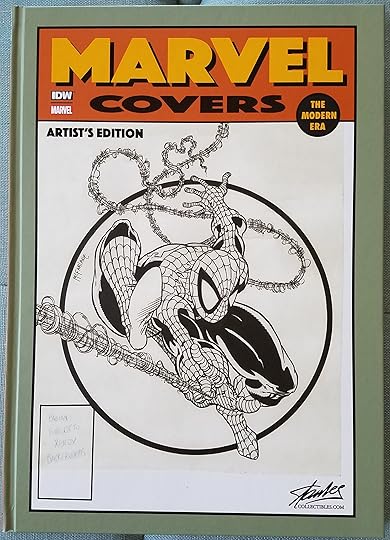
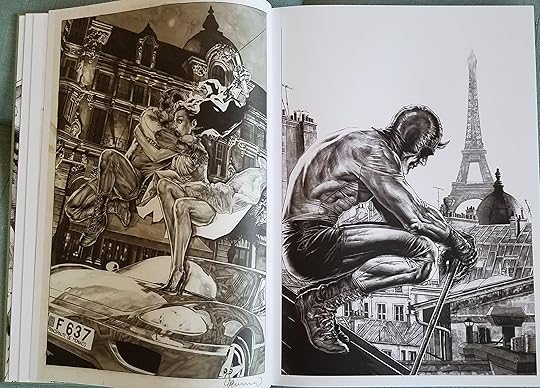

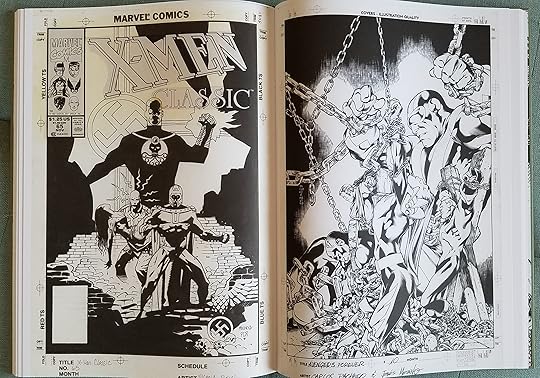

This artist's edition collects some of the best cover art of Marvel's modern era. Many of the industry's top artists are represented here; John Cassaday, Jim Lee, Todd McFarlane, Steve McNiven, Mike Mignola, Joe Quesada, Frank Quitely, John Romita Sr & Jr, and Walt Simonson to name a few.
I sat staring at each page and soaking in the beautiful pencil work of these masters of their craft. For the content it's a bit pricey at the MSRP of $125 but if you can find it cheaper it's worth checking out. It's a collection I know I'll be flipping through from time to time.
 Robocop vs. Terminator Gallery Edition by Dark Horse
Robocop vs. Terminator Gallery Edition by Dark Horse

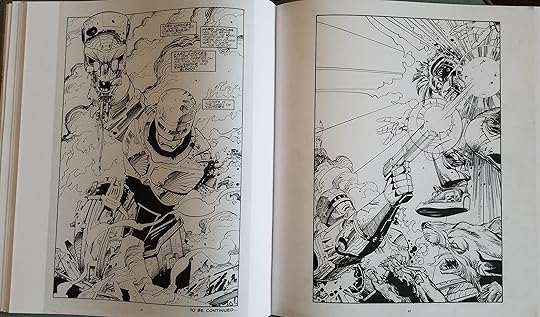

This collects the 4 issue run of Robocop vs. Terminator in its original size as scanned from Walt Simonson's originals.
It's, again, not Frank Miller's best but it's a fun story. Walt Simonson's art is really the draw here though. There are some truly amazing full page and double page spreads.
Each of these Artist's and Gallery Editions is a prestige piece within my collection. They look great on the shelf and they're fun to show off to friends. They're kind of like a backstage pass to see the process by which some of the best artists arrive at the final product. I'm not planning to go overboard on more of these, but if I continue to find them at reasonable prices I'll be picking up more of them.
 Reece wrote: "Robocop vs. Terminator Gallery Edition by Dark Horse (...)This collects the 4 issue run of Robocop vs. Terminator in its original size as scanned from Walt Simonson's originals.
Reece wrote: "Robocop vs. Terminator Gallery Edition by Dark Horse (...)This collects the 4 issue run of Robocop vs. Terminator in its original size as scanned from Walt Simonson's originals. It's, again, not Fr..."
Reece! Great Reviews, great photos, and I'm pleased to find another AE fan. So far, you don't seem to possess the entertaining & crazy-ass AE addiction I myself enjoy suffering from, but I'll do my best to push AE-addictions, and spread the AE-infections. :)
I think your one line sums up the AE appeal:
"Rather than reading them as a book, you have to approach them as a work of art."
Well said; and that's my No.1 priority with AE's - the Artist and Artwork.
That said, there are many AE's, in particular:
- Will Eisner's The Spirit: Vol. 1 & 2 - AE
- The Best of EC: Vol. 1 & 2 - AE
- Jack Davis: EC Stories - AE
- MAD: Artist's Edition
- Frank Miller's Sin City: The Hard Goodbye - AE
- League of Extraordinary Gentlemen - Vol. 1: Gallery Edition
- Mazzuchelli's Daredevil: Born Again - AE
- Best of DC War: AE
... all of these books are also meant to be read AND admired artistically, and I consider them the BEST format for the material they collect.
Why? The Spirit and EC AE's, especially the latter, used 15" x 22" art-boards, and the heavily-detailed work of art legends like Wally Wood, Severin & Elder, Krigstein, Jack Davis lost a lot of it's brilliance at just 25% the original size. All these books from the 50's are Artistic revelations, but they're also fully lettered finished pages, minus the garish and shitty colors. Reading, for example: Wood's Sci-Fi adaptations of Ray Bradbury stories; Kurtzman's brilliant war stories, with art by the Severin-Elder team, Jack Davis, and Kurtzman himself; and the crime and horror artwork of Johnny Craig and Al Feldstein... all at full-size; it's the best way to enjoy the art AND the story.
Others, not so much: the Hellboy in Hell AE is all about the art, though the last 1/4 of the book includes the older short story Hellboy classics, and they're lettered and readable.
But a good rule to go by: Every AE reprinting work from the 1930's - @1997 will be very readable, with lettering on every inked page. From 1998 forward, lettering may or may not be added digitally.
Thanks for the look at the Marvel's Covers AE, Reece. The Todd Macfarlane cover annoyed me, but I'm loving the art samples you provided. Somehow I forgot that Marvel has always used fantastic cover artists. That's one to buy, and it's often on sale.
Nice. :)
 I didn't specify in my earlier posts, but both Ronin and the Robocop vs Terminator Gallery Editions are fully readable. They contain all of the word bubbles for the entire story, which is nice because I hadn't read either of them before getting the gallery editions.
I didn't specify in my earlier posts, but both Ronin and the Robocop vs Terminator Gallery Editions are fully readable. They contain all of the word bubbles for the entire story, which is nice because I hadn't read either of them before getting the gallery editions. The Marvel Covers AE also has a Sam Keith cover that might be more palatable for you if don't like McFarlane. I was surprised how much I enjoyed that one in particular. Without a story to read I thought it might be a quick glance then sit on the shelf, but the quality of the art contained within is worth it if you can find it at a reasonable price.
 Reece wrote: "I didn't specify in my earlier posts, but both Ronin and the Robocop vs Terminator Gallery Editions are fully readable. They contain all of the word bubbles for the entire story, which is nice beca..."
Reece wrote: "I didn't specify in my earlier posts, but both Ronin and the Robocop vs Terminator Gallery Editions are fully readable. They contain all of the word bubbles for the entire story, which is nice beca..."Absolutely; one of the reasons I loved the Mike Mignola Amazing Screw-On Head AE as much as I did is the incredible 60+ pages of Mignola cover art, picking up where 'The Art of Hellboy' left off. When Mignola focused on writing Hellboy, Duncan Fegredo and Richard Corben took over much the artwork. Up until Hellboy in Hell, he spent a few years throwing all of his artistic brilliance into covers for the Mignolaverse titles, and seeing the original art at the full 12" x 17", it looks spectacular. I find myself revisiting that book more often than most, so I think I'll check out the Modern Marvel Covers... the Kieth variant.
Regarding your post about Alan Moore:
It's really a shame DC got involved with ABC. I think if Moore could have continued with his own free-will we would have gotten a lot more from him (like a Season 2 of Top Ten). Imagine what his fertile mind would have come up with had he been able to continue.
Top Ten is definitely my fave and I would put it at number 2 of his best works, and I agree Smax and The 49'ers are both excellent. I was eagerly awaiting the sci-fi book he and Jim Lee had planned, but it never saw the light of day.
I have the original Limited Edition HC of From Hell. I certainly need to reread it and I don't know if subsequent printings have it but the annotations in the back are excellent.
It's really a shame DC got involved with ABC. I think if Moore could have continued with his own free-will we would have gotten a lot more from him (like a Season 2 of Top Ten). Imagine what his fertile mind would have come up with had he been able to continue.
Top Ten is definitely my fave and I would put it at number 2 of his best works, and I agree Smax and The 49'ers are both excellent. I was eagerly awaiting the sci-fi book he and Jim Lee had planned, but it never saw the light of day.
I have the original Limited Edition HC of From Hell. I certainly need to reread it and I don't know if subsequent printings have it but the annotations in the back are excellent.
 Blindzider wrote: "Regarding your post about Alan Moore:
Blindzider wrote: "Regarding your post about Alan Moore:It's really a shame DC got involved with ABC. I think if Moore could have continued with his own free-will we would have gotten a lot more from him (like a Se..."
Oh I know; it pisses me off that DC has ruined what are some of the best comics of the last 30 years. I think Top 10 could easily rate 2nd, my own list of favorite Alan Moore books is similar to my list of favorite Coen Brothers films; any one of them could take the top spot, or the no. 2 spot: No Country for Old Men; Fargo; True Grit; Miller's Crossing; The Big Lebowski; Barton Fink... Still, what we got of Top Ten reads beautifully as a 650-page epic, including Smax, and Promethea is a very complete run, with a sometimes difficult and tedious, often thrilling, and always beautiful book. And LoEG v.1 and 2 are close to perfection, for me.
It seems like a surprising number of people blame Moore for most of the problems, and his prickly and weird persona's partly to blame; but after reading the way he was repeatedly harassed and screwed over by DC, it's hard not to sympathize. They used despicable tactics to ensure cooperation.
I'd love to own the Ltd. Ed. HC of From Hell. One of the things I liked about the original perfect-bound chapters as it was serialized was the crisp, white, glossy coated paper; the black and white art looked superb. I bought the original softcover, and was disappointed by the cheap paper. Does your Ltd. Ed. HC have glossy, coated paper, or an archival matte-finish, or is the paper the cheaper sort from the soft-cover? I need to replace my Eddie Campbell Press-published edition with a nice HC version...
 Blindzider wrote: "Mine has the matte paper."
Blindzider wrote: "Mine has the matte paper."That's fine; is it thick and white or off-white, or yellowed at all? I'm hoping the HC's are acid-free and archival.
It's definitely white, so much that I was surprised at how white it was after all these years. It's more on the thinner side, too. I've been trying to think how to describe or compare it but haven't come up with a good way to do that.
 Blindzider wrote: "It's definitely white, so much that I was surprised at how white it was after all these years. It's more on the thinner side, too. I've been trying to think how to describe or compare it but haven'..."
Blindzider wrote: "It's definitely white, so much that I was surprised at how white it was after all these years. It's more on the thinner side, too. I've been trying to think how to describe or compare it but haven'..."Thanks again, Blindzider; it sounds like archival/acid-free paper, otherwise you'd see yellowing at the edges. I'll have to look for one of the original hardcovers, if there's any around. :)
Eisnein wrote: "Blindzider wrote: "It's definitely white, so much that I was surprised at how white it was after all these years. It's more on the thinner side, too. I've been trying to think how to describe or co..."
No problem. Yeah, there's only one on ebay, sealed, for $1200. They are very rare I believe.
No problem. Yeah, there's only one on ebay, sealed, for $1200. They are very rare I believe.
 The Best Books of 2017, Pt. 1
The Best Books of 2017, Pt. 1This has been quite a year for OHC's, particularly Artist's Editions & Art Monographs of every sort. I've only picked up the Absolute Editions, Omnibus Editions & Deluxe Hardcovers that I considered essentials, or working on complete sets that were good enough I didn't want to wait, and risk them going out of print.
The Hardcover edition of the Milo Manara Library was one I started on with HC Volumes 1 & 2, then managed to snag Volumes 4, 5, & 6 when I realized the softcover editions were replacing the HC's, and copies were dwindling. Vol. 3 was gone, with the marketplace sellers upping the price on Amazon. The unofficial Volume 7, part of the Manara Library, but simply titled 'The Borgias' - no doubt because it's relatively recent, and is not a collection of Manara stories, but one long story, written by Jodorowsky & painted by Manara. Given the 500$+ prices, I settled for the much nicer French Integrale edition, after finding a reasonable price for the Vol. 3 HC, completing the series.
The Manara Library: Vol. 1-6






The now very expensive Dark Horse/Manara Library Edition of 'Borgia' (left), and the larger French Edition (right).


Then there's the 'Hellboy in Hell' addition to the best OHC set around, the 8th entry in the 9" x 12" clothbound HC Hellboy Library Editions from Dark Horse:








The Akira 35th Anniversary Box-set was the first English edition done right-left, and in a beautiful set of Hardcovers, each featuring a different wraparound monochromatic image, as well as retro-styled dustjackets.

The Humanoids 30 x 40 series of tirage luxe hardcovers are French language numbered limited editions of 1500 each; the 30 x 40 refers to the 30cm x 40cm/12" x 16" oversized format. The first of them have been available since 2012, but I purchased 3 of them this month. I've picked up other tirage luxe books in the past, signed & numbered copies by Mezzo, Blutch & Juanjo Guarnido. What immediately impressed me about the first one to arrive, 'Le Garage Hermetique', was its huge & spacious arctic-white pages, providing a beautiful contrast with the flowing, experimental, blacker-than-black line-work of Moebius... giving his improvisational underground BD-masterpiece the epic grandeur it lacks in some of the smaller English editions I first read. The paper itself is like nothing I've seen before; it puts the stock used in the best AE Editions to shame... the matte finish almost looks and feels like coated stock, due to the ultra-dense, super-fine grain, and the double-thick rigidity of the pages make it indistinguishable from the art-board used by comic artists. THIS is the stock every AE should be using. But the last to arrive, after 'Griffe D'Ange', an artbook collaboration between Moebius and his Dune-pal/Incal partner, Alejandro Jodorowsky, was the best of the bunch... 'Final Incal'. Jodo started 'Final Incal' with 'Moebius', then dubbed 'Apres L'Incal'. But after the first album, Moebius was forced to bow out, unable to keep up. Jodo then sought out Jose Ladronn, to redux the first album under the new title, and finish the flagship narrative of the massive Jodoverse, one of the greatest, craziest Space Operas in the comics medium. Ladronn isn't known for his speed, but he's quicker than Travis Charest, the only BD fantasy-SF superstar whose abilities with line & color rival that of Ladronn... and on the world stage, with Milo Manara, Juanjo Guarnido, Geof Darrow, Rafael Grampa, Georges Bess, J.H. Williams 3, Frank Quitely, Lee Bermejo, Alex Ross, Adi Granov, Esad Ribic...



 The Best of 2017, Pt. 2
The Best of 2017, Pt. 2
001. AE's (Artist's Editions):
2017 saw the long awaited debut of the Fantagraphics Studio Edition (FSE) line joined the AE scene as the combined catalog of 'Original Comic Art Facsimile Collected Editions' (or OCAFCE, or OCAF Collected Editions, or OCAF-Coll.Eds., or... um... (view spoiler)whatever...) finally reached the 100-title mark.



After the initial Diamond solicitation, Prince Valiant went AWOL for two fucking years. But when it finally staggered back to the Fantagraphics Company HQ, stinking of Scotch & mumbling about the Saxons & some Princess named 'Aleta', all sins were forgiven. The Prince Valiant FSE, Jaime Hernandez FSE & Charles Burns' Black Hole FSE all arrived in one glorious 3-week period, immediately usurping the AE Throne and Court... and bumping the near-perfect former King's Court down a few spots: Frank Miller's Sin City: The Hard Goodbye Curator's Collection (AE) & the 7 near-perfect E.C. Artist's Editions from IDW, among others released or picked up this past year:



















02. 'La Grande Bibliotheque' Line from Editions Niffle, a Boutique Imprint of 'Le Lombard' & 'Dargaud':
They released their first SIX books in 2017; Integrale Editions of THREE consensus BD classics:
01. Comanche - Œuvres Complètes: Tomes 1 & 2
02. Thogal - Œuvres Complètes: Tomes 1 & 2
03. Blake & Mortimer - Œuvres Complètes: Tomes 7 & 8 (E.P. Jacobs Collection)






Each book is among the best presentations of comic art yet produced. Unlike the N. American AE, these volumes have a slightly different mandate; the Ed. Niffle books also take the highest resolution scans possible from the original art, but instead of an OCAF-Coll. Ed. that leaves the original art raw & untouched, they take it one step further, cleaning up any sign of age or correction.
And instead of matching the original scale, Niffle decided on the perfect published format to show off the brilliant artistry of Hermann, Jacobs & Rosinski: a simple, elegant, line-uniformity of book & jacket design, and an 11" x 14" size with a heavy, lightly-coated archival stock (one that better approximates the feel & look of the original art-boards than the paper used on most of the AE's); they combine to showcase the genius of Hermann, Jacobs & Rosinski better than any publisher to date... a perfect mix of American AE's & Franco-Belgian Tirage de Luxe. The blacks have a jaw-dropping vibrancy & depth, and the bold line-work & delicate hatching are sharp & clear... capturing the greatness of the photographic source and 'triple-distilling' it for purity.
Each Tome collects 5-7 Albums & Short Stories, with a total page-count that varies between 300 to 370-pages.
03. Blueberry - Grande Noir & Blanc (OCAF-Coll. Ed.) Dargaud


 I don't know if this is the right place for this question, but it is related to OHC format and reading, so here goes.
I don't know if this is the right place for this question, but it is related to OHC format and reading, so here goes.I stepped onto the OHC/Omnibus collecting path purely with the intention of collecting as much of the X-Men continuity as it is possible to collect. But... having been on it only a few weeks (and with several Omnis in my possession, some more pre-ordered and some in the mail), I'm beginning to realise just what a gargantuan (and costly) task it will be. I hope that as my initial thirst is sated I can slow down on the purchases and also become better at resisting unrelated book purchases (Spider-Man, Daredevil, West Coast Avengers - I'm looking at all you guys)!
I have started with the Uncanny X-Men Omni vol 1, and have Vol 2 already, Vol 3 and "Classic" on preorder for their reprintings, and Vol 4 on preorder for next year. So obviously, that's the jumping on point I went with. Back to basics. Get the bare-bone history down before all the time-travel/retcon stories that come later on down the line.
But, I think I may have started too early. Maybe I should have jumped on with what I'm more familiar with - the 90s era stuff that I read when I first started reading and collecting comics... I mean straight after UXM Vol 4 Omni, I'm going to hit several really expensive Omnis to continue (Mutant Massacre, Fall of the Mutants, and some rare OHCs).
So if any of you are on the same path, where did you jump on, and how has it gone for you?
 Antony wrote: "I don't know if this is the right place for this question, but it is related to OHC format and reading, so here goes.
Antony wrote: "I don't know if this is the right place for this question, but it is related to OHC format and reading, so here goes.I stepped onto the OHC/Omnibus collecting path purely with the intention of co..."
You’re me, except 4-5 years ago me and buying up what’s most affordable now. I first started collecting X-Men omnis and OHC books that focused on the late 80’s/90’s storylines. Not to brag, but at the time some of those books were pretty cheap. Fall of the Mutants, Inferno prologue and crossovers, bishops crossing, fatal attractions, phalanx covenant, age of apocalypse, onslaught, operation zero tolerance...I used to snag a few each month thinking this was so much easier to collect and read these stories in their entirety as compared to my childhood. Nowadays, crazy how some have jumped up in price so massively. But then makes sense: more and more Many 90’s kids are moving into collecting, reliving their childhood. A lot of those books languished in sales for quite some time, and now that supply has dwindled but not the demand, what’s left is selling for some serious $$$.
Once I got past the era I started in, I went backwards to the very start of X-Men, and nowadays more modern books. I’m now up vol. 4 of UXM (not the omni), during the 2015 “all new, all different Marvel” relaunch. I’ve gotten plenty of good deals over time, but I’ve also paid a pretty penny for sealed copies of books like The X-Men vol. 1, or X-Men: Inferno, some of my most priciest single book acquisitions. The more recent reprints give some hope (UXM 1 & 2), but I just don’t know about reprints of less mainstream books like many of the 90’s collections listed above.
So in short, it’s gone well enough for me. If I could offer you any advice, grab copies of what’s still going for fairly reasonable prices, like X-Tinction Agenda, X-Cutioner’s Song, or recent releases like Shattershot, The Twelve, Eve of Destruction, etc. if reprints happen, great, but if not, you might just have to set custom watches on sites like eBay and jump at a reasonable listing that comes along ever so often.
 noelbeast wrote: "Antony wrote: "I don't know if this is the right place for this question, but it is related to OHC format and reading, so here goes.
noelbeast wrote: "Antony wrote: "I don't know if this is the right place for this question, but it is related to OHC format and reading, so here goes.I stepped onto the OHC/Omnibus collecting path purely with the ..."
Thanks for the advice. I was wondering about strategies. I saw it as a choice of two ways to go. One, as you describe: buy what's available and affordable WHEN it's available and affordable. That may not be the easiest in terms of building a coherent timeline to read through one after the other, but it saves money in the long run.
Or two, buy the next book in the chronology regardless of price - hunting and hoping for as good a deal as I can get.
I'll probably combine both strategies. Tonight I found a copy of the X-Cutioner's Song OHC for £35 on Amazon USA which is by far the cheapest I've seen it. So I'm already in the "bargain hunting" frame of mind! ;)
I live in the faint hope that one day I may be actually up to date with X-Men releases, though knowing the X-Men and their multiple series, off-shoots and changes of directions, I doubt it! (I actually have a reasonable collection of the All-New X-Men and Amazing X-Men floppies from the 2015 relaunch, but that was the last time I was "up to date").
Still, regardless of the challenge, those X books are always so nice to open up and enjoy, especially in oversize format.
I know a lot of people have a specific desire to have what they are reading in physical form, but I read just as much digitally as I do with physical media.
Antony, I bring this up because I read your post as two separate desires (likely because it’s how I approach this hobby).
1. A desire to collect amazing stories in the ultimate physical format; and
2. Ingest as much story in chronological order as possible.
I have read and collected comics nearly my whole life. Around 2nd grade I would grab random floppies off the rack and read as much as I could until about 7th grade (then came music, girls and sports).
After a few years in the real world, I came to the brilliant/bone headed idea of entering law school. Around 2am one fateful night during my first exam period I needed an escape and remembered a long time ago I used to love comics. I jumped into DC and Marvel subscriptions and subscribed to 5 books from each publisher and again I was hooked and have remained so.
I realized I was missing so much continuity and started buying bulk runs of back issues off eBay and LCSs and it quickly became apparent that this is a very expensive hobby no matter how you cut it. At the time I didn’t have the means to ingest the continuity the way I wanted. After a bit of research, I discovered that there was a company called graphic image technology, inc that had the license from Marvel to scan and PDF complete comic runs and they sold these PDFs on a CD Rom to read on your computer.
Today we have Marvel Unlimited, but the point is (albeit in a long about way), if I'm right about the two desires, I recommend you fill in the gaps digitally while you hunt for the beautiful Omni.
Antony, I bring this up because I read your post as two separate desires (likely because it’s how I approach this hobby).
1. A desire to collect amazing stories in the ultimate physical format; and
2. Ingest as much story in chronological order as possible.
I have read and collected comics nearly my whole life. Around 2nd grade I would grab random floppies off the rack and read as much as I could until about 7th grade (then came music, girls and sports).
After a few years in the real world, I came to the brilliant/bone headed idea of entering law school. Around 2am one fateful night during my first exam period I needed an escape and remembered a long time ago I used to love comics. I jumped into DC and Marvel subscriptions and subscribed to 5 books from each publisher and again I was hooked and have remained so.
I realized I was missing so much continuity and started buying bulk runs of back issues off eBay and LCSs and it quickly became apparent that this is a very expensive hobby no matter how you cut it. At the time I didn’t have the means to ingest the continuity the way I wanted. After a bit of research, I discovered that there was a company called graphic image technology, inc that had the license from Marvel to scan and PDF complete comic runs and they sold these PDFs on a CD Rom to read on your computer.
Today we have Marvel Unlimited, but the point is (albeit in a long about way), if I'm right about the two desires, I recommend you fill in the gaps digitally while you hunt for the beautiful Omni.
 I'll add my two cents (whole post is IMO if it isn't obvious). Some of this is just general advice rather than X-Men specific:
I'll add my two cents (whole post is IMO if it isn't obvious). Some of this is just general advice rather than X-Men specific:Superhero continuity is perpetually messy/broken. At this point, we know editors/creators aren't reading/retaining every canon comic ever published, nor is it even a reasonable expectation. There are only a few long runs like Claremont's X-Men or maybe Hickman's Marvel work that had a single writer doing their own thing for years, and they feel coherent/visionary as a result. Thus, for a large majority of superhero comics, it's not really worth trying to "fill gaps" or read in a subjective chronological order (there's no definitive measure for how stories connect or where flashbacks/timelines/dimensions/alt-universes belong), at least not for out-of-print prices per book.
I think of superhero comics not as large/overarching/continuous stories, but instead as collections of smaller, relatively self-contained stories that only sometimes remind readers that they share the same universe. Many comic readers end up preferring solo/team titles or specific arcs/runs to all the contrived/tedious events/crossovers and constantly retconned/relaunched/rebooted continuity. You can always just Google/wiki plot summaries (some people even get more enjoyment out of those than the actual source material). I'm into comics for the quality writing/art that contribute to a storytelling craft unique to the medium, not checking off lists or retaining encyclopedic information about fictional feats (i.e. who punched who when and where).
Like Erik said, you can supplement/mitigate desires to physically collect EVERYTHING by just reading some stories digitally. You may even discover that some popular books are actually not to your liking, which may save you from buying in a premium format or at all.
Completionism can destroy your wallet and, in severe cases, your life. The superhero comics industry is built on selling hundreds of "forever story" $4-5 stapled-paper-with-ads per month that all but require consumers to buy more for a "complete" story. They purposely make product that never fully satisfies desires/compulsions. Manage your resources/expectations. Find the joy in maintaining a lean collection according to your own personal/developed/disciplined methodologies/constraints (e.g. buy Claremont's UXM/NM/Excalibur/XF/etc, and maybe some popular modern runs like Whedon's AXM, Morrison's New XM, Messiah Trilogy, HoX/PoX, etc. but not every other mediocre run in between). Of the options discussed above, I'd just buy what's available at reasonable prices. Avoid buying OOP-priced content. Read that digitally (or just wait if you're not planning to read it all immediately anyway).
If you have other hobbies/responsibilities, it's immediately clear how little time/money/energy/space you actually have to devote to just a single format at a single publisher in a single genre of a single medium. Even taking a step out of Marvel/DC, you can find just as much enjoyment from physical collections without nearly as much headache. Just keep in mind: there are endless amazing comics to explore and only finite personal resources, so be selective/judicious. Every C-tier mass-market comic you buy/own (maybe only to "fill a gap") is potentially pushing out one of your favorite comics of all time that you just haven't discovered yet.
All that said, one of the benefits of a collectible/expensive hobby is that there's a market for resale. Most popular collections you buy can be sold for the original purchase price or 2-6 times over cover price when out of print. After your collection gets to a certain size, it starts to pay for itself as long as you're willing to sell whales and patiently wait (years) for reprints/upgrades. But, that's not to say you can't pickup stuff for cheap. Sometimes print runs are larger than demand and sometimes collectors triple and quadruple -dip content (ew) and dump their older stuff. Pre-owned/used/overstock is an excellent way to sensibly build a collection.
TL;DR Be selective—only buy books you really want. Be honest—evaluate circumstances/available resources for comics. Be patient—upgrades/reprints/deals will come eventually. Try to maintain an objective perspective and healthy relationship with the hobby.
I completely agree with Tiger, and well said. Stay focused. Don’t get everything, only what you enjoy.
 Excellent reply, Tiger, and thank you for sprinkling some common sense on the subject! Very helpful.
Excellent reply, Tiger, and thank you for sprinkling some common sense on the subject! Very helpful.
 Tiger summed my thoughts exactly on this.
Tiger summed my thoughts exactly on this. I only started collecting exclusively collected editions, mostly omnis early last year after moving into my own place. I had the money and space. But I set out with the goal to collect only what I wanted to read and which stories/characters/writers I could re-visit. For Marvel I kind of set out to have what is widely considered the one "best" run for each of my favourite characters, I also stuck to modern. I'd always read a bit online before deciding to buy any omnibus. For example, since I have Hickman's Avengers and FF omnis, I now won't buy another set of omnis for either title. Just to try discipline myself. Maybe in 20 years in my forever home and my future library I'll buy more unnecessary shit, but for now that's my strategy. Spider Man is a little different, I have JMS' omnis, but also the Miles ones, and I do have Stan Lee Vol 1 for the history and I will eventually get Ultimate Spidey, but that's a pipe dream.
Similarly with DC, I have mainly Batman, so I've bought multiple runs, Snyder, Morrison etc. But I've bought my own made up continuity from beginning to end if that makes sense. I only pick which stories I think are "my" stories for a certain character. I have some Wonder Woman, Geoff Johns' Aquaman and my girlfriend has bought some Green Arrow. Other than that, I have never been interested in Superman and I won't buy any just for the sake of the collection. Why would I? I even tried All Star and hated it and that's one unpopular opinion. But I tried it first and then sold it on without losing any money.
I'm now experimenting with Johns' Green Lantern digitally before jumping the gun on those omnis.
I enjoy experimenting more with indie or Image books because there's a wealth of amazing storytelling there that just isn't found in the vast majority of superhero slugfests.
 I started reading Amazing Spider-Man Omnibus Vol 4 a few nights ago.
I started reading Amazing Spider-Man Omnibus Vol 4 a few nights ago.Background: I read contemporary Spider-man titles all the way through from 1990 to the start of the Clone Saga, and have dipped in and out since then. One of my favourite characters (which makes me sad whenever I dip into it these days as it's just not how it used to be - but that's not my point today...)
So I started Vol 4 Omni already aware of a lot of these huge events that happened in "the past" before I started reading Spidey, but which I had never actually read on paper with my own eyes.
And WOW, I'm absolutely loving it! It's so much fun seeing the "old" characters like Flash, the Osbornes, Gwen, MJ, etc, along with the introduction of characters like The Gibbon! This was particularly touching for me, as Gibbon had just recently featured heavily (and meaningfully - no spoilers) in vol 4 tpb of the latest ASM series written by Nick Spencer, so it was great to see when he actually first appeared!
I'd heard a few comments saying that older Spider-man was slow-going, or easy to get bogged down in, but honestly I'm having a blast reading it! I may have to keep an eye out for Vol 3 as well now...
Glad you are enjoying it! I’m a Spidey fan too and V1-3 are my favorite stories. I also like seeing the original concepts and origins of different characters.
 Thanks for sharing all your stories guys! Mine is very similar to NoelBeast too - started collecting TPBs and OHCs five years ago (after I returned to Melbourne from Sydney), and wanted to delve back into my childhood hobby of reading X-Men comics. It got spurred on when my brother bought me the House of M OHC for my birthday one year (yes, he bought it many years after its release), and I realised how "accessible" buying these TPBs/OHCs were online now (versus in the past having to visit the local comic shop in the 90s). Plus, they were a lot cheaper than I thought too! So I started with the Omnibus, then decided to fill in the gap with TPBs. Similar to what Tiger cautioned above - I have a tendency to be a completionist (where possible).
Thanks for sharing all your stories guys! Mine is very similar to NoelBeast too - started collecting TPBs and OHCs five years ago (after I returned to Melbourne from Sydney), and wanted to delve back into my childhood hobby of reading X-Men comics. It got spurred on when my brother bought me the House of M OHC for my birthday one year (yes, he bought it many years after its release), and I realised how "accessible" buying these TPBs/OHCs were online now (versus in the past having to visit the local comic shop in the 90s). Plus, they were a lot cheaper than I thought too! So I started with the Omnibus, then decided to fill in the gap with TPBs. Similar to what Tiger cautioned above - I have a tendency to be a completionist (where possible). I'm a lover of lists and spreadsheets, so naturally I built my own - visited Crushing Krisis website, and the rest is history. I have been quite relieved and impressed with Marvel over the past several years filling in the gaps with reprints (example include X-Men: Blue/Gold #1, Chuck Austen's X-Men runs, the recent Reload TPBs).
First floppy I bought was Uncanny X-Men #300 in 1993. Became a fan in 1995 during the whole Age of Apocalypse crossover (that was the first Omnibus I bought - I *had* to relieve that childhood again!). I think I may have spent over USD 10,000 all up, and have collected a few duplicates (30+ TPBs that eventually became OHC or Omnis). But for me, I see it as a passion and hobby. It's a collector's hobby that can be passed down to my kids/next generation. Plus, it looks great on my wall, and is very un-Millennial of me!
Key outstanding gaps to fill are the Claremont and Lee's X-Men Vol 1-2 Omnis (which are finally being reprinted - finally!) and I'm waiting for an Omni/OHC for Age of X-Man and Dawn of X range. I believe I may have collected all the others, including the spin-off X-teams (Uncanny X-Men, X-Men vol 2, X-Factor all volumes, X-Force all volumes including Uncanny versions, Excalibur, New Mutants and all other "kid" teams, Astonishing, Extraordinary, Amazing, etc.). Will let you guys know once I'm completed my personal goal. :)
Till then, stay safe everyone!
Sean wrote: "Thanks for sharing all your stories guys! Mine is very similar to NoelBeast too - started collecting TPBs and OHCs five years ago (after I returned to Melbourne from Sydney), and wanted to delve ba..."
What's everyone's favorite(s) era?
I'm still partial to the Claremont/Byrne era, I did like the JRJR in the 80's, and also enjoyed the Jim Lee era, although the stories didn't have as much substance looking back. Nothing since then has really grabbed me except for Hickman's stuff, and that's only a couple of the titles.
For Dawn of X, I think I'm just going to get the individual OHCs for a couple of the titles. So far I don't really care for all of them, mainly X-Men and X-Force. An OHC of the Giant Size X-Men would be nice.
What's everyone's favorite(s) era?
I'm still partial to the Claremont/Byrne era, I did like the JRJR in the 80's, and also enjoyed the Jim Lee era, although the stories didn't have as much substance looking back. Nothing since then has really grabbed me except for Hickman's stuff, and that's only a couple of the titles.
For Dawn of X, I think I'm just going to get the individual OHCs for a couple of the titles. So far I don't really care for all of them, mainly X-Men and X-Force. An OHC of the Giant Size X-Men would be nice.
 I'm the world's worst critic! I find pleasure in virtually every film, book, album, picture, so for me, I can't say I "dislike" any particular era of writing. I do particularly like Claremont's writing and Peter David on X-Factor, but also loved Jim Lee's art. The only kind of art I really dislike is where characters are massively deformed or overly "wierd looking", but even then, if the story's good enough I'll still enjoy it for that! Worst critic ever. Or, most tolerant: perfect for an X-Men reader...
I'm the world's worst critic! I find pleasure in virtually every film, book, album, picture, so for me, I can't say I "dislike" any particular era of writing. I do particularly like Claremont's writing and Peter David on X-Factor, but also loved Jim Lee's art. The only kind of art I really dislike is where characters are massively deformed or overly "wierd looking", but even then, if the story's good enough I'll still enjoy it for that! Worst critic ever. Or, most tolerant: perfect for an X-Men reader...
Books mentioned in this topic
Mike Mignola's The Amazing Screw-On Head & Other Curious Objects Artist's Edition (other topics)Alex Toth's Bravo for Adventure: Artist's Edition (other topics)
America's Best Comics: Artist's Edition (other topics)
The Best of DC War - Artist’s Edition (other topics)
Mike Mignola's Hellboy Artist's Edition: Hellboy in Hell and Other Stories (other topics)
More...

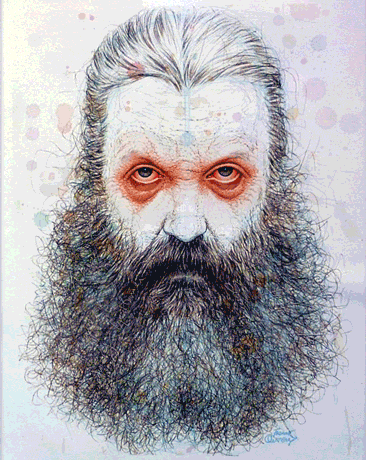





So here's a quick look at 5 thoroughly brilliant 'Artist's Editions'/'A.E.'/'Original Art Facsimile' volumes. IDW are still the gold-standard, but the newer brands, from Graphitti Design, Dark Horse, Kitchen Sink and Fantagraphics are close behind; the quality-level is near-identical, but they lack the same rich back-catalogue that IDW have been building for 7 years and 50 books. I love the classics that IDW have focused on, but the first two Fantagraphics Studio Editions -- the Prince Valiant by Hal Foster book, long overdue, and the Love & Rockets stories of Jaime Hernandez -- along with their history as the one of the best publishers in comics, indicates that every Studio Edition is going to be exciting as fuck... an anticipation I share for the Kitchen Sink Curator's Collection books, because their first release, the 'Sin City' AE, was perfectly executed.
(NOTE: O.A.F. is an alternate for A.E.: O.riginal A.rt F.acsimile. It's an appropriate acronym for these massive, awkward, volumes that always threaten to topple over or destroy your bookcase)
5 Great AE's/OAFs: Ramble 1
001.
The E.C. books on their own are a perfect justification for this format; these are some of the most frequently reprinted stories in comics, but they've never looked better than this. At full size, even the most cramped Feldstein layout is given room to breathe, and all the fine lines that were lost to the smaller page and shitty coloring now make the art seem full and finished, whiteout, blueline, coffee-stains and all. Definitely a must-buy for E.C. fans... and the quality of the reproduction, combined with the impeccable curatorial decisions, make this a great place to start for anyone interested in 'Artist Editions'.
002.
It's been said before, but the second volume is even better than the first... though it's a close call. Like Volume 1, it's loaded up on Kurtzman and Krigstein, something no E.C. fan is going to bitch about. This time there's more Wally Wood material, and Al Williamson is once again given quite a few pages. My one complaint: there's just one story by John Severin & Will Elder, 'Bomb Run'... and since it's likely my favorite 8-pages from either book, it left me wishing there was more. But that's a minor quibble; it's not just a matter of choosing the best E.C. stories, it's also a matter of tracking down the original art. The fact that every page in both volumes (all 4 of the E.C. editions I own, actually, including the MAD and Jack Davis A.E.'s) is reproduced directly from the original art is another impressive feat.
003.
Along with the 'Best of E.C.' Volumes, this may be the best and richest of the Artist's Editions and OAF's to date. Will Elder, Wally Wood, Jack Davis and Basil Wolverton seem to be locked in a game of creative one-up·man·ship that belies the carefully orchestrated chaos of MAD's original creator, editor, writer and cover artist, Harvey Kurtzman. As much as I love the E.C. books written and edited by Al Feldstein, the Kurtzman titles always look better; Feldstein was overly verbose, and his stubborn insistence on shitty mechanical lettering tended to make his pages look excessively cramped. Kurtzman used traditional comic-book lettering, and knew exactly when to shut the fuck up and let the artist speak...
004.
The nearly flawless original pages of 'Sin City: The Hard Goodbye', with they're impressionistic black gradients that enhance the beauty of Miller's chiaroscuro blend of Will Eisner, Jose Munoz, and a young Argentinian named Eduardo Risso, who influenced Miller's new direction as much as Miller's 'B:TDK' and 'Ronin' had influenced Risso himself several years previous, provide a very stark contrast with the material collected in Graphitti Design's 'Batman: The Dark Knight Returns Gallery Edition', with its bluelines, editorial notes, gallons of whiteout, and vellum overlay correction panels (beautifully replicated by Graphitti Design).
005.